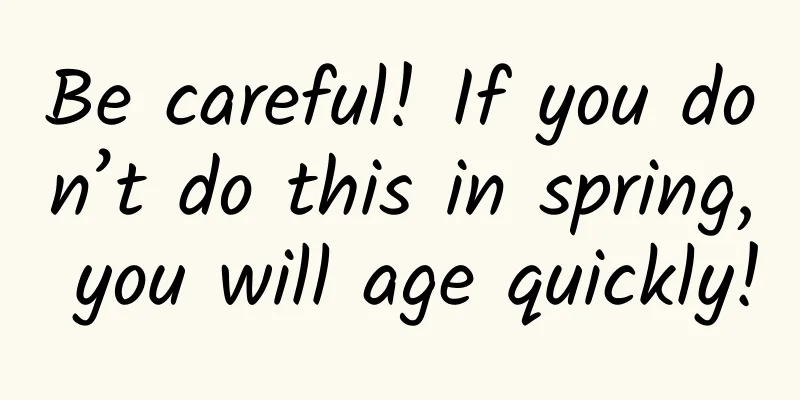Be careful! If you don’t do this in spring, you will age quickly!

|
As the temperature rises, spring is finally here. The warm spring sunshine makes it easy for people to relax their sun protection. But in fact, the spring sun looks gentle, but it is poisonous in secret! The ultraviolet rays in the sun are a big killer of our facial skin. About 80% of facial skin aging is due to photoaging caused by sun exposure. Photodamaged skin loses elasticity, becomes rough and dry, and develops irregular spots and deep wrinkles. 01 Different UV rays have different penetrating powers Based on wavelength, ultraviolet rays can be divided into three types: UVA, UVB and UVC. The wavelength of UVA is between 320 and 400nm, also known as long-wave ultraviolet rays. The wavelength of UVB is between 280 and 320 nm, also known as medium-wave ultraviolet rays. The wavelength of UVC is between 100 and 280 nm, also known as short-wave ultraviolet rays. UVA has the strongest penetrating power and can penetrate clouds and glass. It can also directly reach the dermis of the skin, causing our collagen to disappear, elastic fibers to go on strike, and also triggering the "blackening" action of melanocytes. Therefore, it is mainly responsible for tanning, wrinkling and sun spots on our skin. UVB has a slightly weaker penetrating power and is absorbed by the ozone layer, so only a small amount reaches the earth's surface. Once on the ground, it cannot penetrate glass, parasols, or clothing. But the lethality of UVB should not be underestimated. It can make your skin red and sunburned all year round, and even increase your risk of skin cancer. UVC has the shortest wavelength and is generally directly absorbed by the atmosphere, so it cannot reach the ground and cannot harm our skin. 02 How to choose sunscreen products? Sun protection mainly protects against UVA and UVB. Parasols and sunscreen are essential sun protection products. The PA value marked on sunscreen products is for UVA. PA is actually the abbreviation of Protection Grade of UVA, which means the protection level of long-wave ultraviolet rays. The more +s there are after PA, the better the product’s UVA blocking effect is. Because the most immediate effect of UVA is tanning, you can think of the PA value as the "suntan value". According to the standards of China and Japan, four plus signs are its current limit, so PA++++ is the strongest UVA protection product we can find on the market, which can block most UVA. Sunscreens and some special sun umbrellas are labeled with PA values. Be sure to pay attention to this indicator when purchasing, otherwise your sunscreen may be in vain. Protection against UVB mainly depends on the sun protection factor (SPF). The SPF value is mainly calculated by comparing the skin with and without sunscreen to see how many times the tolerance to UV rays is increased and how many times the sun protection time is extended. If a person is exposed to the sun for 30 minutes without sun protection measures, they will be injured. However, if they apply SPF15 sunscreen, under the same conditions, it will take 7.5 hours, or 450 minutes, for the skin to be sunburned. Therefore, you actually need to choose the SPF value based on the time you are exposed to sunlight, rather than blindly increasing it to the maximum. Because the larger the SPF value, the greater the burden on the skin, blindly pursuing a high value is not friendly to the skin. For daily sun protection, SPF15 is enough, and SPF30 is enough in areas with strong sunlight. If you are going to the seaside or high altitude areas, you can consider SPF50. Of course, no matter how powerful the sunscreen is, you need to apply it in sufficient amounts. In addition, you need to replenish it in time after going out. After all, as we move around and sweat, the sunscreen will be lost to a certain extent, and it will not achieve the most ideal sun protection effect. Of course, remember to remove makeup after applying sunscreen every day, otherwise it will also cause damage if left on the skin overnight. In short, no matter what season it is, we should pay attention to sun protection. Don't think that you don't need sun protection just because the sun is not out or the sun is not that strong. In fact, the weather apps we often use usually have the UV index of the day. As long as the UV index is greater than 3, it is the day when you should take sun protection seriously. Even on cloudy days, the intensity of UV rays is much higher than you think. Therefore, you can take a look at this index every time before going out, and you will find that sun protection is something you really cannot stop for a day! Author: Sydney Review | Xu Min, deputy chief physician of the Department of Dermatology, Zhu Xianyi Memorial Hospital, Tianjin Medical University |
>>: World Sleep Day | It is better to sleep well than to go to bed early
Recommend
Several major hazards of secondhand smoke to women
We often say that smoking is harmful to health, b...
Will the coronavirus Delta and Omicron merge into a more ferocious "new poison king"?
While the Omicron variant is worrying people, two...
What medicine should women take if they experience stinging when urinating?
Whether male or female, they often experience sti...
"Airport" women have this habit
Beautiful breast curves will increase your self-c...
What causes itching in women?
If female friends are not careful, they will expe...
What are the symptoms of a small uterus?
Each of us lives in this world as an independent ...
Is laser useful for enlarged pores?
As we age, we have to use skin care products to c...
There is a small hole in the caesarean section
The wound left after cesarean section is not very...
Tips for first bowel movement after caesarean section
Whether it is after a caesarean section or a natu...
What is the small hard lump under the chest?
Many female friends are often at a loss when smal...
What kind of carpet is good for Nordic style? How to match Nordic style carpet
We all know that carpets are a very common decora...
If you eat this overnight, it will cost you your life
Overnight food is not a terrible thing. As long a...
Health tips for early kidney patients: These points should not be missed!
1. Closely monitor indicators: Regularly check ur...
Leucorrhea with inflammation
Leucorrhea is a barometer of women's health. ...
What does right-rotated uterus mean?
Dextrorotation of the uterus occurs in the late s...









